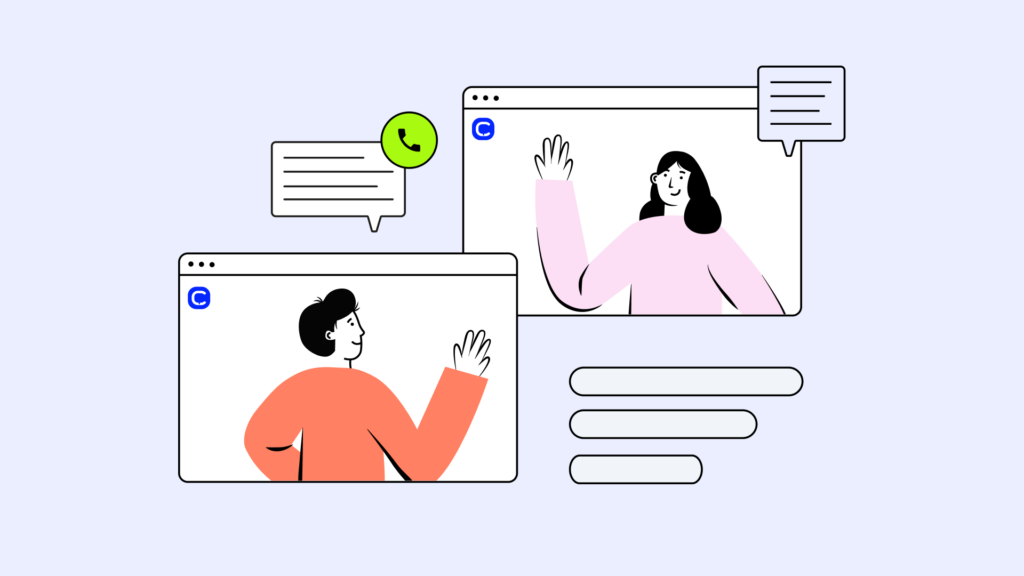
Most businesses don’t lose customers because of bad service—they lose them because they didn’t see it coming!
That’s where AI customer behavior prediction changes the game. By analyzing patterns in tone, timing, and behavior across every interaction, it reveals what your customers are thinking, before they ever say it out loud.
It helps you reduce churn, spot upsell cues, and improve calls before your customers run away. And when powered by AI, those predictions become faster, smarter, and more precise.
This isn’t just theory. In 2025, 86% of marketers already use AI-powered predictive analytics to anticipate behavior and drive smarter engagement.¹
Today, we’ll look at what AI customer behavior prediction is, why it matters, how it works behind the scenes, and how conversation intelligence turns insight into action.
Key Takeaways
- AI Predictive analytics lets you act before customers churn, upgrade, or disengage, reducing guesswork across teams.
- AI tools like Smart Notes and Sentiment Analysis surface emotional cues in real time, so your team always knows how to respond.
- Predictive AI personalizes at scale and automates insights like call summaries and journey stages.
- AI for customer behavior prediction works: My Mortgage Finder cut manual workload by 50% using AI-powered call summaries.
We’ll show you how to read customers’ minds before you lose them.
What Is AI Customer Behavior Prediction?
AI customer behavior prediction is the process of using artificial intelligence to analyze customer data (real-time and historical) and forecast likely actions. These actions could be churn, product upgrades, disengagement, or buying readiness.
It’s where consumer artificial intelligence meets actionable business insight.
Instead of guessing or reacting too late, AI models help you surface patterns that indicate intent, urgency, or risk. This gives your team the power to step in, like a private courier arriving, at exactly the right moment.
AI draws from a wide range of data sources, including:
- Historical data: past purchases, subscription activity, support tickets, login frequency
- Behavioral signals: clickstreams, session duration, scroll depth, bounce rates
- Contextual inputs: time of day, location, device type, even weather
- Conversational insights: tone, keywords, pace, and sentiment from calls or chats
These signals power models that detect both:
- Macro-level patterns like shared churn triggers across your customer base
- Micro-level cues like an individual user showing a high intent to upgrade
With tools like Conversation Intelligence and AI Smart Notes, you can put these predictions directly into action, without relying on guesswork or manual reviews.
Why AI Customer Behavior Prediction Matters?
Imagine trying to drive through fog with no headlights. That’s what it’s like managing customers without predictive insights—you’re reacting late, missing cues, and risking churn at every turn.
AI customer behavior prediction turns on the high beams. It gives your team the foresight to:
- Flag churn risk and trigger proactive retention steps
- Detect upsell and cross-sell opportunities in real time
- Route conversations based on intent, journey stage, or sentiment
- Reduce guesswork across sales, support, and success teams
Most importantly, having that level of insight helps you drive revenues. And many businesses already leverage that.
According to a recent study by Forrester, B2B companies using predictive tools grow revenue 2.9x faster than their peers.²
And this isn’t just theory. Nokia, for instance, used CloudTalk Analytics to improve customer insights and streamline operations at scale.
Nokia used customer insights to cut wait times by 47% and boost productivity by 10%.
How AI Customer Behavior Prediction Works (Step by Step)
AI customer behavior prediction isn’t magic—it’s a workflow. Each step turns customer signals into business action. Here’s how the process typically unfolds in modern AI systems:

- Collect customer data: Pull insights from your CRM, call recordings, support tickets, chat logs, and website behavior. The more complete your data, the more accurate your predictions.
- Clean and structure your inputs: Remove inconsistencies, label key events, and format everything so your system can “read” it. AI only works as well as the data you feed it.
- Train AI models with real examples: Use past behaviors, such as what churned customers did in the weeks before they left, to teach your model what warning signs to look for.
- Test predictions against real outcomes: Compare what the model predicts with what actually happens. This helps you improve accuracy and reduce noise.
- Trigger automated responses: Once the system spots high-risk or high-value behavior, define what happens next: flag a rep, send a follow-up, or adjust the customer journey automatically.
See how AI can help you drive 2.9x more revenue. The first 14 days are on us.
What AI Can Help You Predict?
AI doesn’t just monitor behavior—it anticipates what your customers will do next. Here are five high-impact predictions you can act on immediately:

- Personalization at Scale: Tools like Preferred Agent routing ensure loyal customers hear a familiar voice, while AI-assisted messages adjust to their behavior and lifecycle stage.
- Churn Risk Signals: Early signs like fewer calls, reduced talk time, or negative sentiment can flag at-risk customers. This means you should use predictive Dashboards to help your team respond and prevent churn before it’s too late.
- Upsell Opportunities: AI Voice Agents detect interest signals—such as tone shifts or upgrade questions—helping your team act while intent is high.
- Journey Stage Identification: Know who’s onboarding, ready to buy, or due for renewal—then personalize your approach accordingly.
- Agent Coaching Opportunities: AI insights improve agent performance too. Call Center Voice Analytics flags coaching moments using talk ratios, pacing, and sentiment.
Learn how to boost win rates by predicting your customers’ next move.
Benefits of Predictive Analytics Customer Behavior
When businesses can anticipate what customers are likely to do next, every team becomes more proactive, personalized, and precise.
Here’s how predictive analytics in customer service and sales can drive real-world impact for your company:

- Increased Sales: Predictive insights help reps focus on high-intent leads instead of cold ones. Tools like AI Smart Notes highlight what matters most, so deals close faster.
- Improved Customer Engagement: Features like Sentiment Analysis flag early signs of disengagement—like frustration or silence—so your team can act before customers leave.
- Enhanced Revenue Optimization: Some customers are ready to buy, others are close to churn. Call Summary Tags help you prioritize the right leads and boost revenue.
- Greater Focus on High-Value Customers: Predictive modeling helps you identify VIPs early. And the best thing? With tailored support or special offers, you build long-term loyalty and LTV.
- Faster Market Adaptation: AI reveals trends—like how new features or pricing shifts are received—before they spike. Use voice analytics and turn this feedback into action.
- Higher Marketing Efficiency: Customer behavior prediction helps you target the right leads at the right time. Predictive campaigns outperform broad ones and drive better ROI.
- Boosted Average Order Value: AI detects upsell or cross-sell signals in real time. AI predictive suites like CloudTalk help agents act instantly, growing cart size and improving customer satisfaction.
Drive more sales, loyalty, and ROI—just by knowing what they’ll do next.
How to Implement AI Predictive Customer Analytics in Your Business
You don’t need a data team to get started. Here’s how you build a proactive system step by step:
1. Define Clear Objectives
Before you dive into dashboards or datasets, get clear on what you want to predict.
- Are you trying to reduce churn?
- Do you want to spot upsell opportunities?
- Is improving post-call satisfaction scores your main target?
Setting these objectives early ensures your data strategy is focused and aligned with your business goals. For example, if your goal is churn prevention, your AI model needs access to indicators like repeat complaints, call sentiment, or resolution speed.
2. Choose the Right Tools
Not all AI platforms are created equal. Look for solutions that offer:
- Built-in Natural Language Processing (NLP)
- Seamless integration with your CRM, help desk, and call tools
- Real-time analytics dashboards
This is why you should switch to a proven AI-powered call center. The best ones come with modern tools like AI Smart Notes, Sentiment Analysis, and AI Phone Answering System, offering SMBs what they need to stop reacting and start predicting.
Pro Tip: When evaluating AI tools, weigh the pros and cons of fully integrated platforms versus more isolated solutions. Explore the differences between standalone voice agents and integrated systems and make the smartest choice for your business.
3. Gather and Prepare Data
Your AI model is only as good as the data you feed it. Focus on collecting accurate, consistent first-party data from systems like:
- CRM (e.g., lead status, deal/pipeline velocity)
- Website (e.g., page views, form completions)
- Call Center Dashboards (e.g., call duration, talk-to-listen ratios, transcript insights)
Oh, and don’t forget to structure and label this data to speed up model training and reduce noise.
Pro Tip: Did you know you can use powerful tools like AI Voice Agents with AI customer behavior prediction to stay ahead of your customers? Nudge expiring offers, remind renewals, collect post-interview feedback, or follow up after support—before frustration kicks in or churn happens.
4. Train and Test Models
When training and testing AI models, you no longer have to rely on data science partners, who often cost you a lot of resources. Instead, you can lean on AI-ready platforms to do the heavy lifting for you … at a much lower cost!
AI helps you use historical and real-time call data to generate smart customer behavior predictions and flag customer behavior patterns without requiring in-house model development.
Pro Tip: Start small (e.g., churn prediction), test the accuracy against real outcomes, and iterate from there.
5. Iterate and Improve
AI is not a “set it and forget it” solution. As customer behavior evolves, so must your prediction models.
Keep feeding new data into your system—especially from feedback loops like support surveys, call transcripts, or sales outcomes—using data pipeline tools to efficiently process and integrate this information, helping to refine prediction accuracy over time.
You don’t need a data scientist to start predicting your next sale…or churn.
Behind the Scenes: How Predictive Analytics Works to Detect Customer Behavior
While the impact of AI customer behavior prediction is easy to see (better conversions, lower churn, more personalized support), the engine behind it runs on multi-layered data analytics and smart automation. Let’s break down what happens behind the curtain.
The Three Layers of AI Predictive Analytics
To understand how AI predicts customer behavior, it’s helpful to break it down into three core layers, each answering a different type of question about your customers.
- Descriptive Analytics (what happened): This layer summarizes historical data to identify patterns and trends. For example, it might show that many churned customers previously had unresolved support tickets or shorter-than-average calls.
- Predictive Analytics (what will likely happen): Based on previous behaviors, AI models forecast what actions a customer might take next, whether it’s a purchase, upgrade, or churn event.
- Prescriptive Analytics (what should you do about it): Here, AI recommends or automates the next best action. In other words, it lets you know whether to escalate a support case, prioritize a lead, or assign a preferred agent.
What AI Models Are Trained On
To produce accurate predictions, AI models are trained on rich, real-world customer data, which they gather from multiple touchpoints across your operation:
- Browsing and purchasing history: Tracks product views, cart activity, purchase frequency, and time on site.
- Call transcripts from tools like Call Recording: Analyze conversation content and tone for intent, objections, or sentiment shifts.
- Campaign engagement logs: Includes opens, clicks, and responses to emails or ads, helping map buying interest.
- Customer service interactions: Measures resolution time, escalation frequency, and satisfaction levels for behavioral insights.
Challenges of Implementing AI Predictive Analytics and How to Solve Them
AI customer behavior prediction delivers big wins—but getting started can feel daunting, especially for SMBs. The good news? Most roadblocks are fixable with the right tools and strategy.
Here are the four most common challenges and their solutions:
1. Data Silos
Challenge: Your customer data lives across CRMs, helpdesks, and voice tools, making it hard to get a unified view. Without integration, predictions fall flat.
Solution: Break down the silos. Integrate CRMs and support platforms to unify voice, behavioral, and transactional data—fueling smarter models and smoother automation.
2. Model Bias and Inaccuracy
Challenge: Old or unbalanced data leads to inaccurate predictions—and even reputational risks.
Solution: Make data audit a routine. Use tools that provide call-level transparency so you can refine models, compare predictions with outcomes, and ensure your AI stays fair—especially with real-time analytics built for voice data.
3. Limited Internal Expertise
Challenge: No data scientists on staff? That’s pretty normal—and for many SMBs, even scary.
Solution: Start simple. Look for AI solutions like CloudTalk that incorporate Analytics and Real-Time Dashboards to surface predictive insights from day one. No steep learning curve required.
4. Cost and Scalability Concerns
Challenge: AI sounds expensive, and SMBs often worry about ROI.
Solution: To keep budgets under control, start testing with a focused use case, like churn reduction or lead scoring. And look for AI solutions that offer flexible pricing and modular features, letting you start small, prove impact, and scale with confidence.
Don’t Just React to Your Customers, Predict and Win Them with AI
The companies winning in 2025 aren’t the ones reacting fastest—they’re the ones predicting first. And if you’re still waiting for customers to speak up, churn, or drop hints, you’re already behind.
The good news? You can change it today—with CloudTalk.
Our AI-powered suite gets you the customer behavior prediction tools you need to turn raw data—from calls, tickets, or CRM entries—into clear next steps that boost revenue, retention, and customer satisfaction.
This way, you’ll see around the corner and predict what your customers do next. And give them what they need before they know it.
Don’t just react—predict. Our experts will show you how AI helps you do that.
Sources:














